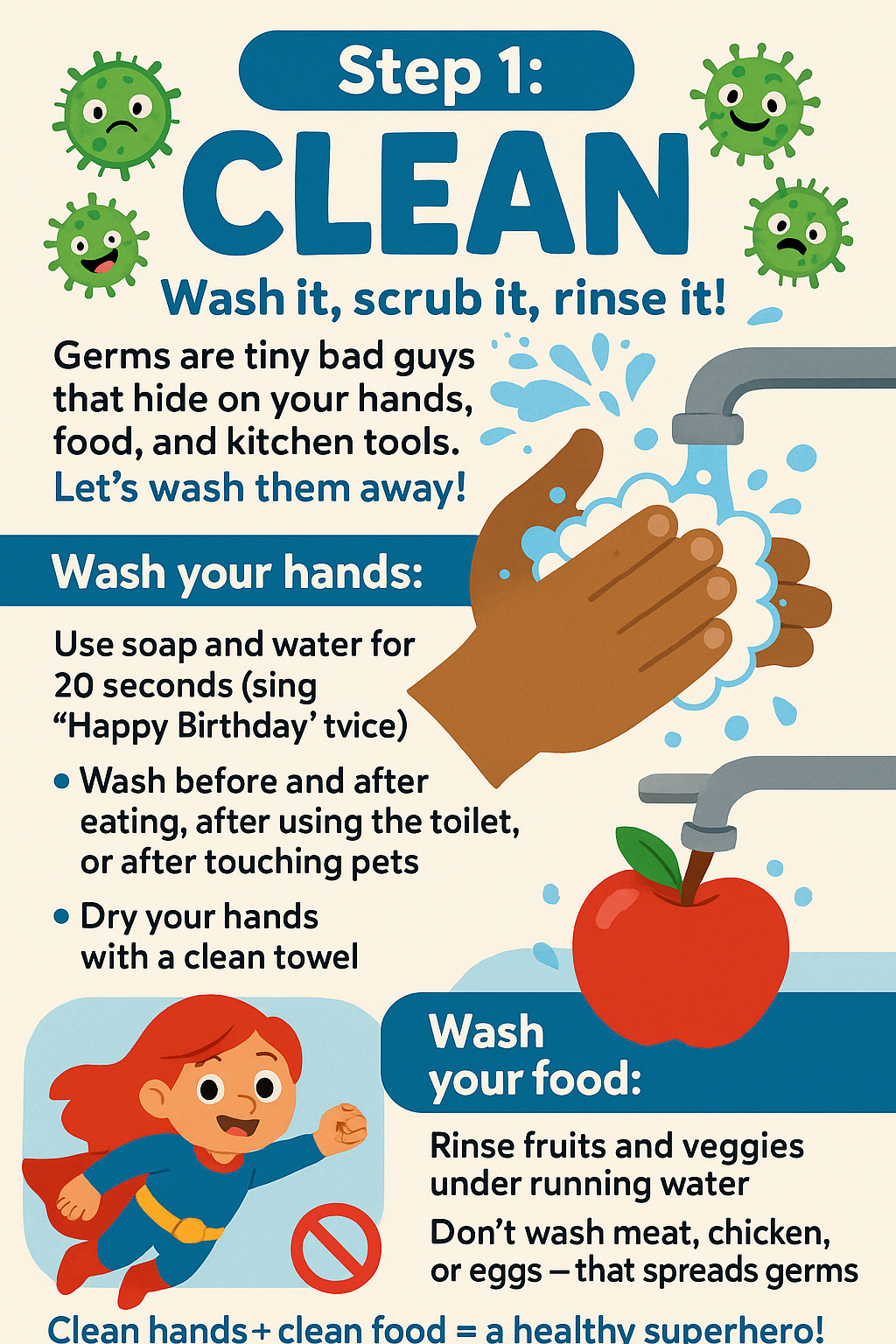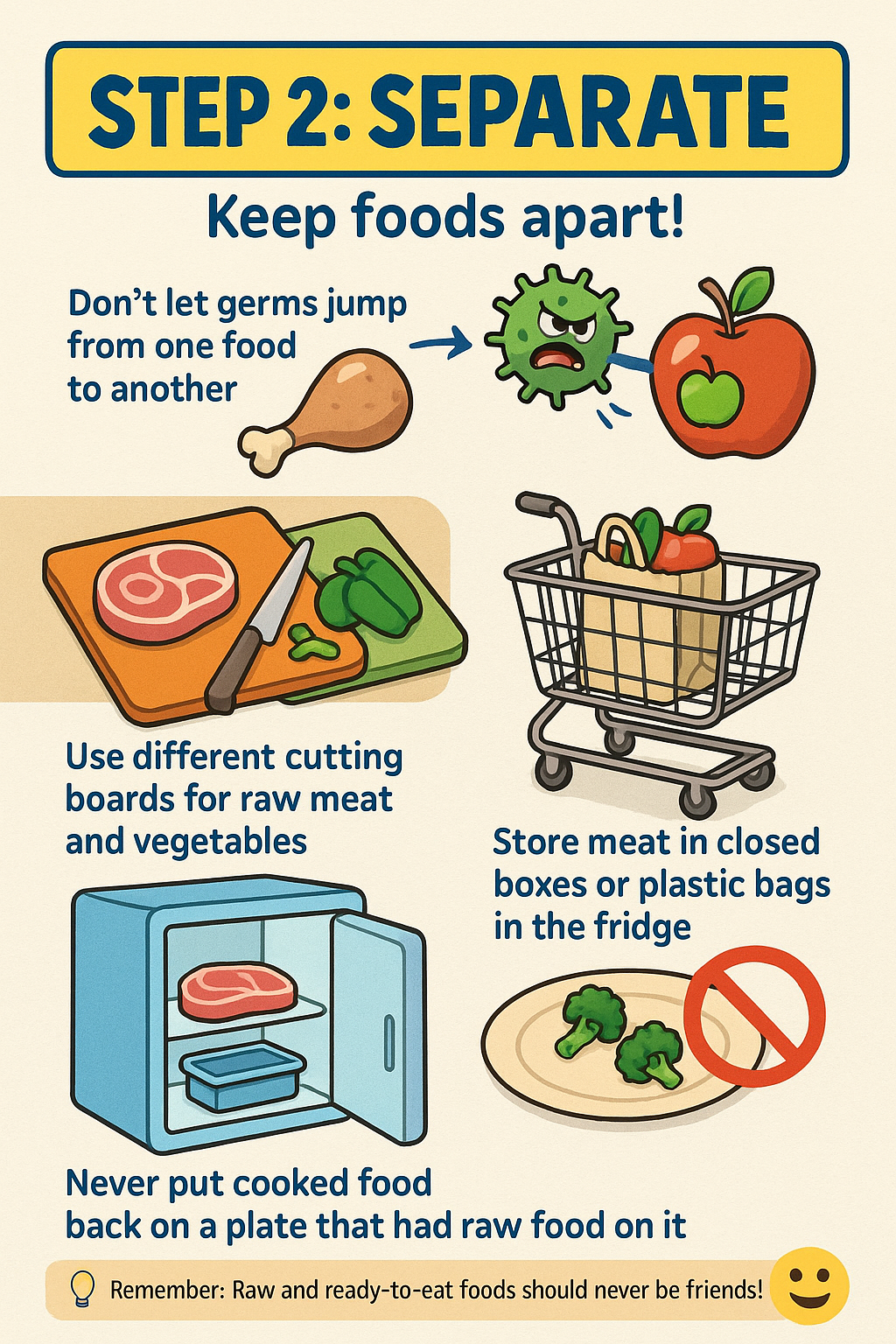🍽️ Keep Food Safety
NutriKid's 4 Steps!
(Keep your tummy happy and germs away!)
Hi friends! 👋 I'm NutriKid, your kitchen buddy!
Millions of people get sick from bad food every year 😷
Let's learn 4 easy steps to stay safe!
Step 1: CLEAN
Germs 🦠 hide on hands, food, and tools. Wash them away! 💦
👋 Wash hands:
- • Soap + water for 20 sec (sing "Happy Birthday" twice 🎶)
- • Before/after eating, toilet, touching pets
🍎 Wash food:
- • Rinse fruits & veggies
- • Don't wash meat/eggs 🚫
💡 Clean = Healthy! 🦸♀️

Step 2: SEPARATE
Don't let germs jump! 🦠➡️🍏
- • Different boards for raw meat & veggies
- • Separate bags when shopping 🛒
- • Store meat in closed containers
- • Never reuse plates with raw food
💡 Keep raw & cooked apart! 😄

Step 3: COOK
Heat kills germs! 🍲
- • Cook until steaming hot
- • Keep hot (above 60°C / 140°F)
- • Stir microwaved food
💡 Hot food = Happy tummy! ❤️🔥

Step 4: CHILL
Cold keeps germs asleep 😴
- • Refrigerate within 2 hours (1 hr in summer)
- • Keep fridge below 4°C / 40°F
- • Thaw in fridge, not counter
- • Don't eat old/smelly food 🤢
💡 Chill fast, germs won't last! ❄️

Safe Food - What Should You Look For?
Complete Food Safety Checklist
When eating out or buying food, use this checklist to ensure everything is safe. Check the food handler, the food itself, water, ice, utensils, and the environment.
1. The Food Handler
Health & Appearance
- • Looks healthy, no sneezing or coughing
- • Wears clean, fresh clothes
- • Neat and tidy hair (tied back or covered)
Hygiene
- • Clean hands & trimmed nails
- • No jewelry on fingers or wrist
- • No cuts or skin infections (or wears fresh gloves)
Safe Serving
- • Uses clean spatula/spoon (not bare hands)
- • Doesn't touch body, mobile, or money before food
Good Habits
- • Doesn't smoke or chew tobacco while working
- • Changes gloves often if wearing them
2. The Food
Protection
- • Always covered (no flies or dust)
- • Free from dirt, hair, or bugs
- • Properly heated before serving
Temperature
- • Not kept at room temp for 2+ hours
- • Ice cream is properly frozen
- • Hot food stays hot, cold stays cold
Quality Check
- • Looks, feels, smells & tastes fresh
- • Not touched without clean hands
- • Nutritious and healthy
Packaging
- • Seals are intact (not torn or opened)
- • Within 'best before' or 'expiry' date
- • No mixing old leftovers with fresh food
3. The Water
- • Running potable water - Safe for drinking (not stagnant water)
- • Covered container - Stored in clean, covered containers with a side tap (not dipped with cups)
4. The Ice
- • Made from safe water (potable water only)
- • Hygienically stored in clean, leak-proof containers
- • Handled with clean spoons (not bare hands)
- • Storage ice should not be added to beverages
5. The Utensils
Cleanliness
- • Clean and intact (no cracks or chips)
- • Washed, cleaned & disinfected after each use
- • Tables and counters kept clean
Reuse Rules
- • Single-use items NOT reused
- • Disposable plates used once only
Safe Packaging
- • Non-toxic material for packing
- • NO printed paper/newspaper for wrapping food
Material Safety
- • Food-grade materials only
- • No harmful chemicals or dyes
6. The Environment
Cleanliness
- • No open drains nearby
- • No garbage dumps around
- • Clean toilets (not near kitchen)
- • Properly disinfected
Comfort
- • Airy and well-ventilated
- • Well-lit (can see clearly)
- • Not crowded or cramped
Pest-Free
- • No flies, cockroaches, or rats
- • Screens on windows
- • Regular pest control
Safety Scoring Guide
When eating out, check how many points are followed:
- • 0-2 areas safe: Be careful, consider another place
- • 3-4 areas safe: Acceptable safety level
- • 5-6 areas safe: Excellent food safety standards
Food Safety Outdoors
Before You Go:
- Pack food in insulated coolers with ice packs
- Separate raw meat from ready-to-eat foods
- Bring hand sanitizer and wet wipes
- Pre-cook food at home when possible
During Outdoor Cooking:
- Wash hands before handling food
- Cook meat thoroughly (use a thermometer)
- Don't leave food out for more than 2 hours (1 hour if hot)
- Use separate plates for raw and cooked food
Safety Tip: Keep coolers in the shade and avoid opening them frequently to maintain cold temperature!
Food Safety When Cooking
Preparation Safety:
- Always wash hands for 20 seconds with soap
- Clean all surfaces and utensils before use
- Tie back hair and wear an apron
- Use different cutting boards for meat and vegetables
- Check expiry dates on all ingredients
Cooking Temperatures:
- Poultry: 75°C (165°F)
- Ground Meat: 70°C (160°F)
- Eggs: Cook until yolk is firm
- Leftovers: Reheat to 75°C (165°F)
💡 Ask an adult to help with stoves, ovens, and sharp knives!
Food Safety When Shopping
Smart Shopping Tips:
- Check expiry/best-before dates
- Look for intact packaging (no dents, tears, or leaks)
- Pick cold/frozen items last
- Separate raw meat from other groceries in cart
- Use insulated bags for frozen/chilled foods
What to Look For:
- Avoid cans with bulges or rust
- Don't buy cracked or dirty eggs
- Skip produce that's bruised or moldy
- Choose bright, fresh-looking fruits & veggies
- Read ingredient labels for allergens
Speed Tip: Go straight home after shopping and refrigerate cold items within 1 hour!
Food Safety and Storage
Refrigerator Rules:
- Keep fridge at 4°C (40°F) or below
- Store raw meat on bottom shelf (to prevent drips)
- Cover all food with lids or plastic wrap
- Label leftovers with date
- Use leftovers within 3-4 days
Pantry & Freezer:
- Store dry goods in cool, dry place
- Keep opened items in airtight containers
- Freezer should be -18°C (0°F) or below
- Wrap food well before freezing
- Rotate stock: "First In, First Out"
🥛 Dairy
Use within 5-7 days
🥗 Cooked Veggies
3-5 days in fridge
🍖 Cooked Meat
3-4 days in fridge
Food Safety While Travelling
Travelling Smart:
- Pack non-perishable snacks (crackers, nuts, dried fruit)
- Bring bottled water (especially in new places)
- Use insulated lunch bags with ice packs
- Carry hand sanitizer for before meals
- Avoid street food in unfamiliar locations
Eating Out Safely:
- Choose busy restaurants (food turnover is faster)
- Check cleanliness of restaurant
- Avoid raw or undercooked foods abroad
- Peel fruits yourself when possible
- Say no to ice in drinks if water safety is unsure
Warning Signs - Don't Eat If:
- • Food smells bad or looks spoiled
- • Food has been sitting out in the heat
- • You're unsure how long it's been there
- • Packaging is damaged or open